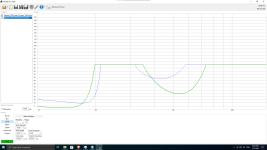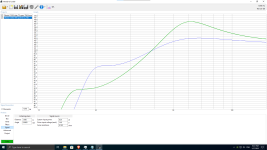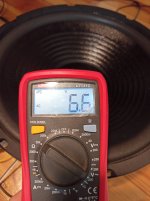I recently got the cheap Dibeisi g1202-8 12" subwoofer driver. By making it push a ruler I measured its Xmax to be a terrible 2.5mm It's 4mm Now 6mm Now ~9mm excursion.
However what concerns me is the TS parameters.
Using the REW software you can calculate them at home. The issue is the ones I get from my "measuring system" are very different from what the manufacturer states. In the WinISD screenshot you can see the numbers according to the manufacturer. In the REW one you can see my results. Are my results reasonable/within a realistic range? Which would you trust more?
However what concerns me is the TS parameters.
Using the REW software you can calculate them at home. The issue is the ones I get from my "measuring system" are very different from what the manufacturer states. In the WinISD screenshot you can see the numbers according to the manufacturer. In the REW one you can see my results. Are my results reasonable/within a realistic range? Which would you trust more?
Attachments
Last edited:
The link with driver specs you provided is from the "Speakerboxlite.com" website, their database is not a manufacturer statement.The issue is the ones I get from my "measuring system" are very different from what the manufacturer states.
The Speakerboxlite.com lists the Re at 7.2, the WinISD Re is 7.2, but "Znom" is 10.In the WinISD screenshot you can see the numbers according to the manufacturer.
They look reasonable for your particular sample.In the REW one you can see my results. Are my results reasonable/within a realistic range? Which would you trust more?
Not knowing your or the Speakerboxlite.com measurement procedure, or if the two samples were from the same production run, I would not "trust" either to represent both.
I don't understand how you determined the Xmax to be 2.5mm, but looking at online photo examples of that driver, it seems plausible.
Art
Art, your remarks are right. I should have clarified some things.
1. I linked to speakerboxlite.com so people can see the driver. The box the driver came in, has the parameters written on it and those are the ones I use as "manufacturer values".
2. Yes, Znom should read 8.
3. Point 1. The values are not calculated by speakerboxlite.com and
3.5 Basically according to REW documentation, you can do a calibration using a simple resistor circuit, then measuring the impedance of the driver at a range of frequencies and finally do the T/S calculation choosing a method. I chose the "added mass" method so at the last measurement I add 30g of mass to the driver's cone to drop the Fs and REW calculates based on the differences (excellent video by Audio Judgement).
4. I placed a ruler on a box and aligned it against the center of the cone. The point "3cm" was right on the edge of the box. I played a 3Hz sine and the maximum excursion without hitting the back/"tak-tak" sounds, was able to move the "2.75cm" point on the edge of the box. Hence 0.25cm Xmax.
1. I linked to speakerboxlite.com so people can see the driver. The box the driver came in, has the parameters written on it and those are the ones I use as "manufacturer values".
2. Yes, Znom should read 8.
3. Point 1. The values are not calculated by speakerboxlite.com and
3.5 Basically according to REW documentation, you can do a calibration using a simple resistor circuit, then measuring the impedance of the driver at a range of frequencies and finally do the T/S calculation choosing a method. I chose the "added mass" method so at the last measurement I add 30g of mass to the driver's cone to drop the Fs and REW calculates based on the differences (excellent video by Audio Judgement).
4. I placed a ruler on a box and aligned it against the center of the cone. The point "3cm" was right on the edge of the box. I played a 3Hz sine and the maximum excursion without hitting the back/"tak-tak" sounds, was able to move the "2.75cm" point on the edge of the box. Hence 0.25cm Xmax.
Attachments
Has the driver been broken in? This would relax the suspension, lowering Fs and Qt, possibly raising Xmax.
Just a thought....
Just a thought....
"Xmax" is linear excursion, should be the point where distortion reaches ~10%.4. I placed a ruler on a box and aligned it against the center of the cone. The point "3cm" was right on the edge of the box. I played a 3Hz sine and the maximum excursion without hitting the back/"tak-tak" sounds, was able to move the "2.75cm" point on the edge of the box. Hence 0.25cm Xmax.
A conservative mechanically derived Xmax is voice coil length minus top plate thickness/2.
Your driver manufacture gives no information that can be used to determine the driver's Xmax, which is a bad sign for a "subwoofer", as Xmax is arguably the most important parameter.
Your test did not determine Xmax.
"Xlim" or "Xmech" is the limit of suspension parts, or voice coil former hitting the back plate.
Usually Xlim is much greater than Xmax, 2.5mm Xlim would be unusual for a woofer with such a large suspension.
Try determining exactly the source of the "tak-tak" noise by pushing the cone evenly by hand forward and back.
Too long tinsel leads can make slapping noises.
The OP's driver's Fs is 35.4Hz, 6.4Hz lower than the factory spec of 41.8Hz.Has the driver been broken in? This would relax the suspension, lowering Fs and Qt, possibly raising Xmax.
Xmax won't change with break in, though an errant glob of glue stuck to the pole piece or magnet structure during manufacture can mechanically limit travel, while still passing a low power test:
Applying some pressure by hand (or hammering with a sine wave) may pop the drop of glue loose.
Decades ago, (before a decent internet connection made research quick and easy) I was unsure if Xmax was measured one-way or peak to peak.
A woofer specified with 9mm Xmax "bottomed out" ("Tak-Tak noise") at ~5mm one way travel.
After some more testing, the glob of glue was disintegrated, and it worked fine, and I understood that it's Xlim of 15.5mm should have allowed 31mm peak to peak travel before any parts hit their limit.
Since then, I have always done a "hand test" of the driver's suspension to determine what the limit is.
Art
Last edited:
Thank you Art for the insight! The idea of a hand test didn't occur to me. The source of early "tak-tak" sounds was my phone's soundcard clipping at that low frequency. I connected the amp (class D, chip=TPA3116D2) to my PC and my new measurement is 4mm for the driver to start "bottoming out". Happens at around 20W (including heat losses) 3Hz sinewave. It can be pushed to around 23W with a little distortion. And these are free-air values, not with enclosure.
So now I guess I can use the TS parameters I get from REW in WinISD to finally put it in an enclosure.
(Today I received the Blow A-300. A 12" driver which is much heavier, boasts a much higher "power rating" (yeah these cheap ones mean electrical handling, not mechanical too) and almost double the price of the Dibeisi G1202. But its Xmax appears to be similar. I 'll make another post about it)
*Edit: added photos. The 6.6V was measured across the speaker terminals.
So now I guess I can use the TS parameters I get from REW in WinISD to finally put it in an enclosure.
(Today I received the Blow A-300. A 12" driver which is much heavier, boasts a much higher "power rating" (yeah these cheap ones mean electrical handling, not mechanical too) and almost double the price of the Dibeisi G1202. But its Xmax appears to be similar. I 'll make another post about it)
*Edit: added photos. The 6.6V was measured across the speaker terminals.
Attachments
Here's WinISD with mine and Dibeisi's TS parameter values. They look kind of weird. Both use the same box volume, tuning frequency and signal is at 30W. The aim is to get 20-25Hz at audible levels, no way for these to play loud. Blue line is their TS values. (I may have to look at my measuring system)
Edit: Also, WinISD says "Driver data fails integrity check" with my values.. I don't know.
Edit: Also, WinISD says "Driver data fails integrity check" with my values.. I don't know.
Attachments
-
 Screenshot 2025-01-27 222932 WinISD.png95.6 KB · Views: 29
Screenshot 2025-01-27 222932 WinISD.png95.6 KB · Views: 29 -
 Screenshot 2025-01-27 221830 WinISD.png95.3 KB · Views: 30
Screenshot 2025-01-27 221830 WinISD.png95.3 KB · Views: 30 -
 Screenshot 2025-01-27 222040 WinISD.png95.4 KB · Views: 27
Screenshot 2025-01-27 222040 WinISD.png95.4 KB · Views: 27 -
 Screenshot 2025-01-27 222057 WinISD.png89.3 KB · Views: 26
Screenshot 2025-01-27 222057 WinISD.png89.3 KB · Views: 26 -
 Screenshot 2025-01-27 222115 WinISD.png97.9 KB · Views: 35
Screenshot 2025-01-27 222115 WinISD.png97.9 KB · Views: 35 -
 Screenshot 2025-01-27 222135 WinISD.png99.2 KB · Views: 27
Screenshot 2025-01-27 222135 WinISD.png99.2 KB · Views: 27 -
 Screenshot 2025-01-27 222150 WinISD.png93.2 KB · Views: 29
Screenshot 2025-01-27 222150 WinISD.png93.2 KB · Views: 29 -
 2025-01-27 225130 WinISD.jpg28.9 KB · Views: 28
2025-01-27 225130 WinISD.jpg28.9 KB · Views: 28
Last edited:
Sounds like you still have not done it.The idea of a hand test didn't occur to me.
Again, you are not measuring Xmax with your procedure, and it is unlikely the driver is reaching Xlim ("bottoming out") with your test, unless you have verified by hand that is the case.The source of early "tak-tak" sounds was my phone's soundcard clipping at that low frequency. I connected the amp (class D, chip=TPA3116D2) to my PC and my new measurement is 4mm for the driver to start "bottoming out".
6.6v is ~6 watts into a 7ohm load.(Today I received the Blow A-300. A 12" driver which is much heavier, boasts a much higher "power rating" (yeah these cheap ones mean electrical handling, not mechanical too) and almost double the price of the Dibeisi G1202. But its Xmax appears to be similar. I 'll make another post about it)
*Edit: added photos. The 6.6V was measured across the speaker terminals.
Depending on your power supply voltage and current, the PA3116D2 may be clipping at that level.
Although 10% second harmonic distortion in a subwoofer driver does not sound bad, 10% in a chip amp often sounds horrible.
The distortion levels go from a fraction of a % to over 100% in a few watts range.
You already confirmed hard clipping (square waves), sounds like "bottoming out" to you.
Best of luck sorting out your simulations.
Art
I'm very glad I had someone like you doubt my results. I gave 22V DC to the driver and now the highest excursion I 've measured is 6mm. This TPA3116D2 amp was indeed clipping at that point too, I could make it give up to 12V AC measured across the speaker terminals with little distortion. I 've torture-tested this amp in the past by making it output 2x45W with a car light of 1.5Ω per channel.
Alright, so now I have done the "ruler test" completely by hand (it's harder without using the electromagnet) and the limit seems to be about ~9mm excursion. I say not bad. The G1202 cost me 37€ including shipping. I just need a higher power amp if I want to use it better. It 'll probably be class D again. I'm fine with their audio quality.
High expectations in terms of what? Audio quality compared to a 150€ driver? Sure. Also ~9mm is Xlim pretty much.I think you have too high expectations for such a cheap Chinese driver. Besides, the TS parameters of these speakers are unlikely to be suitable for an enclosure application. It might be a good driver for a dipole.
I 'll have an enclosure for it soon, so I'll report how it sounds (perhaps new thread).
And I don't think I like dipoles, although if the Vas I measured is correct, it may make things harder.
The speakers you bought areHigh expectations in terms of what? Audio quality compared to a 150€ driver? Sure. Also ~9mm is Xlim pretty much.
I 'll have an enclosure for it soon, so I'll report how it sounds (perhaps new thread).
And I don't think I like dipoles, although if the Vas I measured is correct, it may make things harder.
trash, whose parameters quoted by the manufacturer, are rubbish. Do not expect either good parameters or good sound quality from such a product.
- Home
- Loudspeakers
- Subwoofers
- DIY Thiele/Small parameters measurement differences











